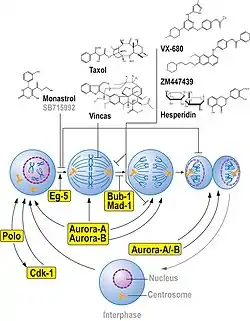 | |
 | |
| Names | |
|---|---|
| IUPAC name
ethyl 4-(3-hydroxyphenyl)-6-methyl-2-sulfanylidene-3,4-dihydro-1H-pyrimidine-5-carboxylate | |
| Other names
Monastrol | |
| Identifiers | |
3D model (JSmol) |
|
| ChEBI | |
| ChEMBL | |
| ChemSpider | |
PubChem CID |
|
CompTox Dashboard (EPA) |
|
| |
| |
| Properties | |
| C14H16N2O3S | |
| Molar mass | 292.35344 |
Except where otherwise noted, data are given for materials in their standard state (at 25 °C [77 °F], 100 kPa).
Infobox references | |
Monastrol is a cell-permeable small molecule inhibitor discovered by Thomas U. Mayer in the lab of Tim Mitchison. Monastrol was shown to inhibit the kinesin-5 (also known as KIF11, Kinesin Eg5), a motor protein important for spindle bipolarity.[1]
Mechanism of action

Monastrol inhibits Eg5
Monastrol binds to a long loop that is specific to the Eg5 (also known as KIF11 or kinesin-5) kinesin family, and allosterically inhibits ATPase activity of the kinesin [2]
References
- ↑ Thomas U. Mayer; Tarun M. Kapoor; Stephen J. Haggarty; Randall W. King; Stuart L. Schreiber; Timothy J. Mitchison (1999). "Small Molecule Inhibitor of Mitotic Spindle Bipolarity Identified in a Phenotype-Based Screen". Science. 286 (5441): 971–974. doi:10.1126/science.286.5441.971. PMID 10542155. S2CID 15348455.
- ↑ Maliga Z, Kapoor TM, Mitchison TJ (September 2002). "Evidence that monastrol is an allosteric inhibitor of the mitotic kinesin Eg5". Chem. Biol. 9 (9): 989–96. doi:10.1016/S1074-5521(02)00212-0. PMID 12323373.
This article is issued from Wikipedia. The text is licensed under Creative Commons - Attribution - Sharealike. Additional terms may apply for the media files.